Artist impression of the three worlds – higher, middle and lower spheres of the universe
Description and Quotes from Śrīmad-Bhāgavatam
Compiled by: Pariksit Das
Loka-traya – the 3 planetary systems
“There are three planetary systems, namely the lower worlds, the intermediate worlds and the upper worlds. The human beings on earth are situated at the beginning of the intermediate worlds, but living beings like Brahmā and his contemporaries live in the upper worlds, of which the topmost is Satyaloka. In Satyaloka the inhabitants are fully cognizant of Vedic wisdom, and thus the mystic cloud of material energy is cleared.” (SB 1.19.23)
As stated in the Bhagavad-gītā, there are three divisions of material spheres in this universe, namely the ūrdhva-loka (topmost planets), madhya-loka (midway planets) and adho-loka (downward planets). Beyond the ūrdhva-loka planets, that is to say above the Brahmaloka, are the material coverings of the universes, and above that is the spiritual sky, which is unlimited in expansion, containing unlimited self-illuminated Vaikuṇṭha planets inhabited by God Himself along with His associates, who are all eternally liberated living entities.
Ūrdhvaloka (ऊर्ध्वलोक).—The “upper world” or ūrdhvaloka is above mount Meru.
The celestial world, the realms of the gods or heavens, the svarga-lokas – heavenly planets.
Madhya-loka – the middle planetary system, world of mortals, the realms of the humans, animals and plants.
Adhaloka (अधलोक).—The adha-loka (Adholoka) is the lower world, the subterranean heavens, Bila-Swarga, the realms of beings other than humans, like Daityas, Dānavas and Nāgas etc.
Ancient Greek – Mayan – Sumerian conception of the tree-tiered Universe
The 3-layered planetary systems and the 14 worlds
According to the purāṇas this universe is called loka-traya- the three lokas (Bhūrloka, Bhuvarloka and Svarloka), or three spheres (or worlds) consisting of 14 planetary systems. In the material world, the planetary systems are arranged in three spheres, called triloka, or Svarga, Martya and Pātāla.
The three worlds are the upper, lower and middle intermediate planets of the universe. The human beings on earth are situated at the beginning of the intermediate worlds, but living beings like Brahmā and his contemporaries live in the upper worlds, of which the topmost is Satyaloka.
When we speak of loka-traya, we refer to the three primary planetary systems—Bhūḥ, Bhuvaḥ and Svaḥ—into which the universe is divided. Surrounding these planetary systems are the eight directions, namely east, west, north, south, northeast, southeast, northwest and southwest. Lokāloka Mountain has been established as the outer boundary of all the lokas to distribute the rays of the sun and other luminaries equally throughout the universe. (sb/5/20/37)
Lord Brahmā is the creator of the three worlds, namely the lower planets, called the Pātālalokas, the middle planets, called the Bhūrlokas, and the upper planets, called the Svarlokas. Still higher planets, such as Maharloka, Tapoloka, Satyaloka and Brahmaloka. The upper three planetary systems are called sāttvika planets because they provide facilities for a long duration of life and relative freedom from disease and old age, as well as a sense of fearlessness. The great sages and saints are promoted beyond the heavenly planets to Maharloka. In the creation, during Brahmā’s day, the three planetary systems—Svarga, Martya and Pātāla—revolve, and the inhabitants, including the lower animals, human beings, demigods and Pitās, appear and disappear in terms of their fruitive activities.
The cosmic manifestation is grossly divided into three worlds, the upper, lower and middle planetary systems, and then it broadens into the cosmos of fourteen planetary systems. There are fourteen divisions, Caturdaśa-bhuvana. There are seven down and seven up. We are in the middle. This is called Bhūrloka. Above this, there is Bhuvarloka. Above that, there is Janaloka. Above that, there is Maharloka. Above that, there is Satyaloka. Above that, there is Brahmaloka, the highest planetary system. Similarly, down also, we have got Tala, Atala, Talātala, Vitala, Pātāla, Rasātala. This information we get from Vedic literature, fourteen worlds. Each and every universe is consisting of these fourteen planetary systems, and there are innumerable universes.
The fourteen worlds –lokas– or spheres
The fourteen lokas or worlds are generally called as Caturdaśa-bhuvanas. Of these, six lokas (worlds) are above the earth (Bhuloka) and seven below it.
The vedic concept of the 14 lokas state that they are divided into 7 upper worlds (Svargaloka) and the 7 lower ones, generally known as the Pātālas.
The universe is divided into fourteen planetary systems. Seven planetary systems, called Bhūr, Bhuvar, Svar, Mahar, Janas, Tapas and Satya, are upward planetary systems, one above the other. There are also seven planetary systems downward, known as Atala, Vitala, Sutala, Talātala, Mahātala, Rasātala and Pātāla, gradually, one below the other. In this verse, the description begins from the bottom because it is in the line of devotion that the Lord’s bodily description should begin from His feet. Śukadeva Gosvāmī is a recognized devotee of the Lord, and he is exactly correct in the description. (SB 2.1.26, Purport)
Modern enterprisers (the astronauts who travel in space) may take information from Śrīmad-Bhāgavatam that in space there are fourteen divisions of planetary systems. The situation is calculated from the earthly planetary system, which is called Bhūrloka. Above Bhūrloka is Bhuvarloka, and the topmost planetary system is called Satyaloka. These are the upper seven lokas, or planetary systems. And similarly, there are seven lower planetary systems, known as Atala, Vitala, Sutala, Talātala, Mahātala, Rasātala and Pātāla lokas. All these planetary systems are scattered over the complete universe, which occupies an area of two billion times two billion square miles. (sb/2/5/40-41)
The 14 planetary systems are named as follows, from highest to lowest:
1) Satya-loka
2) Tapa-loka
3) Jana-loka
4) Mahar-loka
5) Svar-loka
6) Bhuvar-loka
7) Bhūr-loka
8) Atala-loka
9) Vitala-loka
10) Sutala-loka
11) Talātala-loka
12) Mahātala-loka
13) Rasātala-loka
14) Pātāla-loka
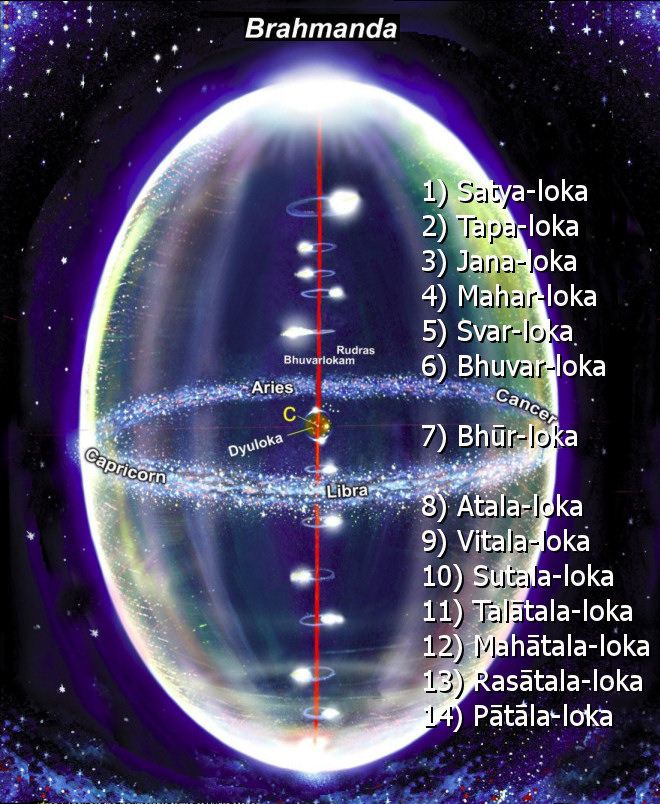 The fourteen worlds are enumerated in Śrīmad-Bhāgavatam, Second Canto, Fifth Chapter. The upper planetary systems are (1) Bhū, (2) Bhuvar, (3) Svar, (4) Mahar, (5) Janas, (6) Tapas and (7) Satya. The seven lower planetary systems are (1) Tala, (2) Atala, (3) Vitala, (4) Nitala, (5) Talātala, (6) Mahātala and (7) Sutala. The lower planets, as a whole, are called Pātāla. Among the upper planetary systems, Bhū, Bhuvar and Svar constitute Svargaloka, and the rest are called Martya. The entire universe is thus known as Triloka.
The fourteen worlds are enumerated in Śrīmad-Bhāgavatam, Second Canto, Fifth Chapter. The upper planetary systems are (1) Bhū, (2) Bhuvar, (3) Svar, (4) Mahar, (5) Janas, (6) Tapas and (7) Satya. The seven lower planetary systems are (1) Tala, (2) Atala, (3) Vitala, (4) Nitala, (5) Talātala, (6) Mahātala and (7) Sutala. The lower planets, as a whole, are called Pātāla. Among the upper planetary systems, Bhū, Bhuvar and Svar constitute Svargaloka, and the rest are called Martya. The entire universe is thus known as Triloka.
This universe is called fourteen different planetary systems, and we are wandering in these different planetary systems (up- and down, life after life). If we are pious, then we are promoted to the higher planetary system, Svargaloka, Janaloka, Maharloka, Tapoloka, Brahmaloka, Satyaloka. There are so many… Siddhaloka. And if we are impious, then we are downtrodden. We go down more and more. Ūrdhvaṁ gacchanti sattva-sthāḥ (BG 14.18). If you are situated in sattva-guṇa, then you are promoted to the higher planetary system: adho gacchanti tāmasāḥ. Jaghanya-guṇa-vṛtti-sthā adho gacchanti tāmasāḥ. If you are infected with tamo-guṇa, then you go down, down, down, down. Madhye tiṣṭhanti rājasāḥ. And if we are infected by the modes of passion, then we keep ourselves in the middle. But Kṛṣṇa says in the Bhagavad-gītā, ābrahma-bhuvanāl lokāḥ punar āvartino ‘rjuna (BG 8.16). Even if you go to the highest planetary system—it is called Brahmaloka—where the duration of life is very, very long… That is described in the Bhagavad-gītā: sahasra-yuga-paryantam ahar yad brahmaṇo viduḥ (BG 8.17).
Situation of the planetary systems
The planetary systems are situated within the stem of the lotus flower growing from the navel of lord Viṣṇu.
From Viṣṇu’s navel, the stem of a lotus flower grows, and on that lotus flower the first creature, Brahmā, is born. Within the stem of that lotus flower are fourteen divisions of planetary systems, which are created by Brahmā.
Lord Brahmā is the most exalted personality in the universe because of his causeless devotional service unto the Lord in mature transcendental knowledge. He therefore created all the fourteen planetary divisions for inhabitation by the different types of living entities. (sb/3/10/9)
Thus engaged in the service of the Supreme Personality of Godhead, Lord Brahmā entered into the whorl of the lotus, and as it spread all over the universe he divided it into three divisions of worlds and later into fourteen divisions. (SB 3.10.8, Translation)
The seven lower planetary systems
“…below the earth by 70,000 yojanas are the 7 lower planetary systems—Atala, Vitala, Sutala, Talātala, Mahātala, Rasātala and Pātāla. Demons and Rakṣasas live in these lower planetary systems with their wives and children, always engaged in sense gratification and not fearing their next births. The sunshine does not reach these planets, but they are illuminated by jewels fixed upon the hoods of snakes. Because of these shining gems there is practically no darkness. Those living in these planets do not become old or diseased, and they are not afraid of death from any cause but the time factor, the Supreme Personality of Godhead.
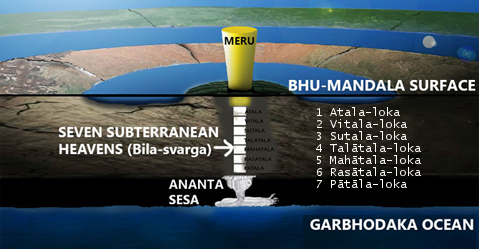
In the planet Atala, the yawning of a demon has produced three kinds of women, called svairiṇī (independent), kāmiṇī (lusty) and puṁścalī (very easily subdued by men). Below Atala is the planet Vitala, wherein Lord Śiva and his wife Gaurī reside. Because of their presence, a kind of gold is produced called hāṭaka. Below Vitala is the planet Sutala, the abode of Bali Mahārāja, the most fortunate king. Bali Mahārāja was favored by the Supreme Personality of Godhead, Vāmanadeva, because of his intense devotional service. The Lord went to the sacrificial arena of Bali Mahārāja and begged him for three paces of land, and on this plea the Lord took from him all his possessions. When Bali Mahārāja agreed to all this, the Lord was very pleased, and therefore the Lord serves as his doorkeeper. The description of Bali Mahārāja appears in the Eighth Canto of Śrīmad-Bhāgavatam.
Below Sutala is the planet Talātala, the abode of the demon Maya. This demon is always materially happy because he is favored by Lord Śiva, but he cannot achieve spiritual happiness at any time. Below Talātala is the planet Mahātala, where there are many snakes with hundreds and thousands of hoods. Below Mahātala is Rasātala, and below that is Pātāla, where the serpent Vasukī lives with his associates.” (sb/5/24/24_summary)
This idea of ‘seven lower planetary systems’ may create the impression in a person’s mind of seven layers of many globe-like planets orbiting in space somewhere below the assumed Earth globe. The term ‘planetary systems’ was Śrīla Prabhupāda’s choice of words, and it is a term that he used consistently, but our modern conception of what might constitute ‘planetary systems’ is wholly different from what is being described by Śukadeva Goswami as seven huge realms within the one vast Earth circle. From the very beginning of Śrīmad Bhāgavatam, Śrīla Prabhupāda was translating verses relating to the Bhū-maṇḍala without even have a map or image of Bhū-maṇḍala to help him conceptualize where each place is situated, and how each place is related to the other.
The Fifth Canto especially presents a detailed description of the universal form that is very difficult to follow without a map, or depiction, or explanation of any kind. Without a map, or image, or explanation, the description of the virāṭ-rūpa (universal form) is very difficult to visualize. Śrīla Prabhupāda invariably used the word ‘planet’ to cover the multitude of places mentioned by Śukadeva Goswami. However, one should be aware that many of the places that Śrīla Prabhupāda refers to as ‘planets,’ are actually references to places upon the Bhū-maṇḍala’s vast landscape, or within the depths of the Bhū-maṇḍala itself (the subterranean realms). They are not ‘other planets’ as we conceive them, but part of the Earth itself. As we shall see presently, the conception of seven layers of globe-like planets floating below the Earth is definitely not what is being described by Śukadeva Goswami. (Please refer to: Mayesvara Das, What’s Below the Earth? , Oct 2017)
Description of the upper, heavenly realms
Satyaloka
The highest planet is Satyaloka, or Brahmaloka, where the prime person of this universe, Lord Brahmā, resides. We have seen already that we can hardly calculate the wondrous condition of life in Brahmaloka, but the highest condition of life, the mode of goodness, can bring us to this.
The human beings on earth are situated at the beginning of the intermediate worlds, but living beings like Brahmā and his contemporaries live in the upper worlds, of which the topmost iTapa-lokas Satyaloka. In Satyaloka the inhabitants are fully cognizant of Vedic wisdom, and thus the mystic cloud of material energy is cleared.
In that planet of Satyaloka, there is neither bereavement, nor old age nor death. There is no pain of any kind, and therefore there are no anxieties, save that sometimes, due to consciousness, there is a feeling of compassion for those unaware of the process of devotional service, who are subjected to unsurpassable miseries in the material world. The duration of life in Satyaloka is calculated to be 15,480,000,000,000 years. (sb/2/2/27)
Tapa-loka
Tapoloka means those who have performed here severe penances, and they are transferred there in Tapoloka. In Tapoloka, when there is destruction, annihilation of this material world, in the Tapoloka there is no destruction. The higher planetary systems, beginning with Maharloka, Janaloka and Tapoloka, are not inundated at the time of this devastation.
In the upper planetary systems (Svargaloka, Janaloka, Tapoloka, Maharloka, Brahmaloka, etc.) the living entities enjoy a longer duration of life, an increased amount of knowledge, and a generally more blissful existence. Viśvanātha Cakravartī Ṭhākura estimates that Dhruvaloka, the polestar, is 3,800,000 yojanas above the sun. Above Dhruvaloka by 10,000,000 yojanas is Maharloka, above Maharloka by 20,000,000 yojanas is Janaloka, above Janaloka by 80,000,000 yojanas is Tapoloka, and above Tapoloka by 120,000,000 yojanas is Satyaloka. Thus the distance from the sun to Satyaloka is 233,800,000 yojanas, or 1,870,400,000 miles.
Jana-loka
Great saintly persons, after death, they go to Janaloka or Maharloka. One in goodness attains higher planetary systems, like Brahmaloka or Janaloka, and there enjoys godly happiness. The word amalān is significant; it means “free from the modes of passion and ignorance.” There are impurities in the material world, but the mode of goodness is the purest form of existence in the material world. There are different kinds of planets for different kinds of living entities. Those who die in the mode of goodness are elevated to the planets where great sages and great devotees live.
The Personality of Godhead said: O son of self-born Brahmā, once long ago on Janaloka, wise sages who resided there performed a great sacrifice to the Absolute Truth by vibrating transcendental sounds. These sages, mental sons of Brahmā, were all perfect celibates. At that time you happened to be visiting the Lord on Śvetadvīpa—that Supreme Lord in whom the Vedas lie down to rest during the period of universal annihilation. A lively discussion arose among the sages on Janaloka as to the nature of the Supreme Absolute Truth. Indeed, the same question arose then that you are asking Me now. (SB 10.87.9)
At that time you happened to be visiting the Lord on Śvetadvīpa—that Supreme Lord in whom the Vedas lie down to rest during the period of universal annihilation. A lively discussion arose among the sages on Janaloka as to the nature of the Supreme Absolute Truth. Indeed, the same question arose then that you are asking Me now.
The (cosmic) devastation takes place due to the fire emanating from the mouth of Saṅkarṣaṇa, and thus great sages like Bhṛgu and other inhabitants of Maharloka transport themselves to Janaloka, being distressed by the warmth of the blazing fire which rages through the three worlds below. (SB 3.11.30)
Mahar-loka
The yogī alone goes beyond this circle of Śiśumāra and attains the planet [Maharloka] where purified saints like Bhṛgu and others enjoy a duration of life of 4,300,000,000 solar years. This planet is worshipable even for the saints who are transcendentally situated.
The great sages and saints are promoted beyond the heavenly planets to Maharloka, but that also is not the place of complete fearlessness because at the end of one kalpa the Maharloka is annihilated and the inhabitants have to transport themselves to still higher planets.
In the Maharloka one can live even at time of partial annihilation of the universe. The annihilation begins with volcanic flames of fire emanating from the mouth of Shesha Ananta Deva from the lowest portion of the universe. By such big blazing fire, the heat reaches up to Maharloka and the residents thereof pass to Brahmaloka which exists up to twice the duration of parardha(?) time.
Svar-loka
The karmīs, or fruitive workers, can elevate themselves to the Svargaloka planets, which include the sun and the moon. The moon, the sun and higher planets are called svargaloka. There are three different statuses of planets: higher, middle and lower planetary systems. The earth belongs to the middle planetary system. In the word svārājyasya, svar refers to Svargaloka, the heavenly planet, and svārājya refers to the ruler of the heavenly planet, Indra.
The denizens of heaven, who live in the planetary systems beginning from Svarloka, cannot even see Lord Viṣṇu in Śvetadvīpa. Unable to reach the island, they can simply approach the beach of the milk ocean to offer transcendental prayers to the Lord, appealing to Him on special occasions to appear as an incarnation.
At the end of Lord Brahmā’s day, everything up to Svargaloka is inundated with water, and the next morning, when there is darkness in the universe, Brahmā again brings the phenomenal manifestation into existence. Therefore he is described here as he who manifests this universe.
Indra, King of the higher planetary system, has the power to push down any conditioned soul attempting to go from the lower to the higher planets without proper qualifications. The modern attempt to go to the moon is also an attempt by inferior men to go to Svargaloka by artificial, mechanical means. This attempt cannot be successful. From this statement of Indra it appears that anyone attempting to go to the higher planetary systems by mechanical means, which are here called māyā, is condemned to go the hellish planets in the lower portion of the universe. To go to the higher planetary system, one needs sufficient good qualities. A sinful person situated in the mode of ignorance and addicted to drinking, meat-eating and illicit sex will never enter the higher planets by mechanical means. (sb/8/11/5)
Bhuvar-loka
The demigods, semi-demigods, Gandharvas, Cāraṇas, Vidyādharas, etc., are all highly intelligent persons in the upper planets, the human beings are inhabitants of the intermediate planets, and the asuras are inhabitants of the lower planets.
While He was passing in the northern direction, all the celestial denizens known as Cāraṇas and Gandharvas, as well as the munis and the damsels of the heavenly planets, prayed and offered Him all respects. The ocean offered Him oblations and a place of residence.
The lower systems are called Bhūrloka, the middle systems are called Bhuvarloka, and the higher planetary systems, up to Brahmaloka, the highest planetary system of the universe, are called Svarloka. This middle portion of the sky is called Bhuvarloka, as confirmed by both Śrīla Viśvanātha Cakravartī and Śrīla Jīva Gosvāmī.
Ūrdhvam means higher planetary system. Here it is said that api trailokya-rājyasya hetoḥ. Trailokya. Oṁ bhūr bhuvaḥ svaḥ. This is bhūr-loka. Above this, bhuvar-loka, and above that, svar-loka, heavenly planets. Oṁ bhūr bhuvaḥ svaḥ tat savitur vareṇyam. This is Gāyatrī-mantra.
Bhūr-loka
The planetary system in which we are living is called Bhūrloka, so this is called bhūrloka, earthly planet. If you keep yourself in the rajo-guṇa, then you will keep within this Bhurloka. And if you are infected with the tamo-guṇa, then you again go to lower grade life, again animal life, plant life. This is the nature’s process. You cannot avoid it.
Śukadeva Gosvāmī says he will explain the Bhūrloka. In the fifth verse he starts to be more precise about the Bhū-maṇḍala planetary system. It says, “It resembles a lotus flower.” It has the shape of a lotus flower. “And the seven islands of Jambūdvīpa resemble the whorl of that flower.” Then “The length and breadth of that island known as Jambūdvīpa…”
The planetary system known as Bhū-maṇḍala resembles a lotus flower, and its seven islands resemble the whorl of that flower. The length and breadth of the island known as Jambūdvīpa, which is situated in the middle of the whorl, are one million yojanas [eight million miles]. Jambūdvīpa is round like the leaf of a lotus flower.
Antarikṣa
Antarikṣa, is the space between Bhūrloka and Bhuvarloka. The sun is situated [vertically] in the middle of the universe, in the area between Bhūrloka and Bhuvarloka, which is called antarikṣa, outer space. The distance between the sun and the circumference of the universe is twenty-five koṭi yojanas [two billion miles].
Beneath Vidyādhara-loka, Cāraṇaloka and Siddhaloka, in the skycalled antarikṣa, are the places of enjoyment for the Yakṣas, Rākṣasas, Piśācas, ghosts and so on. Antarikṣa extends as far as the wind blows and the clouds float in the sky. Above this there is no more air. (sb/5/24/5)
Bila-svarga
Bila-svarga is known as the heavenly subterranean worlds. The heavenly places of enjoyment are divided into three groups: the celestial heavenly planets, the heavenly places on earth, and the bila heavenly places, which are found in the lower regions. Among these three classes of heavenly places (bhauma-svarga-pada-ni), the heavenly places on earth are the eight varṣas other than Bhārata-varṣa.
Everything in the subterranean heavens is very nicely arranged. There are well situated residential quarters, there is a pleasing atmosphere, and there are no bodily inconveniences or mental anxieties, but nevertheless those who live there have to take another birth according to karma. In these subterranean heavens [bila-svarga], there are very beautiful houses, gardens and places of sense enjoyment, which are even more opulent than those in the higher planets because the demons have a very high standard of sensual pleasure, wealth and influence. Most of the residents of these planets, who are known as Daityas, Dānavas and Nāgas, live as householders. Their wives, children, friends and society are all fully engaged in illusory, material happiness. The sense enjoyment of the demigods is sometimes disturbed, but the residents of these planets enjoy life without disturbances. Thus they are understood to be very attached to illusory happiness.
My dear King, in the imitation heavens known as bila-svarga there is a great demon named Maya Dānava, who is an expert artist and architect. He has constructed many brilliantly decorated cities. There are many wonderful houses, walls, gates, assembly houses, temples, yards and temple compounds, as well as many hotels serving as residential quarters for foreigners. The houses for the leaders of these planets are constructed with the most valuable jewels, and they are always crowded with living entities known as Nāgas and Asuras, as well as many pigeons, parrots and similar birds. All in all, these imitation heavenly cities are most beautifully situated and attractively decorated.
The parks and gardens in the artificial heavens surpass in beauty those of the upper heavenly planets. The trees in those gardens, embraced by creepers, bend with a heavy burden of twigs with fruits and flowers, and therefore they appear extraordinarily beautiful. That beauty could attract anyone and make his mind fully blossom in the pleasure of sense gratification. There are many lakes and reservoirs with clear, transparent water, agitated by jumping fish and decorated with many flowers such as lilies, kuvalayas, kahlāras and blue and red lotuses. Pairs of cakravākas and many other water birds nest in the lakes and always enjoy in a happy mood, making sweet, pleasing vibrations that are very satisfying and conducive to enjoyment of the senses.
Description of the lower, subterranean realms
There are seven lower planetary systems, known as Atala, Vitala, Sutala, Talātala, Mahātala, Rasātala and Pātāla lokas. All these planetary systems are scattered over the complete universe, which occupies an area of two billion times two billion square miles.
My dear son Nārada, know from me that there are seven lower planetary systems out of the total fourteen. The first planetary system, known as Atala, is situated on the waist; the second, Vitala, is situated on the thighs; the third, Sutala, on the knees; the fourth, Talātala, on the shanks; the fifth, Mahātala, on the ankles; the sixth, Rasātala, on the upper portion of the feet; and the seventh, Pātāla, on the soles of the feet. Thus the virāṭ form of the Lord is full of all planetary systems. (SB 2.5.40-41)
The width and length of the seven lower planetary systems are calculated to be exactly the same as those of earth.
Demons and Rakṣasas live in these lower planetary systems with their wives and children, always engaged in sense gratification and not fearing their next births. Since there is no sunshine in those subterranean planets, time is not divided into days and nights, and consequently fear produced by time does not exist. The sunshine does not reach these planets, but they are illuminated by jewels fixed upon the hoods of snakes. Many great serpents reside there with gems on their hoods, and the effulgence of these gems dissipates the darkness in all directions. Because of these shining gems there is practically no darkness. Those living in these planets do not become old or diseased, and they are not afraid of death from any cause but the time factor, the Supreme Personality of Godhead.
Atala
In the planet Atala, the yawning of a demon has produced three kinds of women, called svairiṇī (independent), kāmiṇī (lusty) and puṁścalī (very easily subdued by men).
In Atala there is a demon, the son of Maya Dānava named Bala, who created ninety-six kinds of mystic power. Some so-called yogīs and svāmīs take advantage of this mystic power to cheat people even today. Simply by yawning, the demon Bala created three kinds of women, known as svairiṇī, kāmiṇī and puṁścalī. The svairiṇīs like to marry men from their own group, the kāmiṇīs marry men from any group, and the puṁścalīs change husbands one after another.
If a man enters the planet of Atala, these women immediately capture him and induce him to drink an intoxicating beverage made with a drug known as hāṭaka [cannabis indica]. This intoxicant endows the man with great sexual prowess, of which the women take advantage for enjoyment. A woman will enchant him with attractive glances, intimate words, smiles of love and then embraces. In this way she induces him to enjoy sex with her to her full satisfaction. Because of his increased sexual power, the man thinks himself stronger than ten thousand elephants and considers himself most perfect. Indeed, illusioned and intoxicated by false pride, he thinks himself God, ignoring impending death.
Vitala
Below Atala is the planet Vitala, wherein Lord Śiva and his wife Gaurī reside. Because of their presence, a kind of gold is produced called hāṭaka.
The next planet below Atala is Vitala, wherein Lord Śiva, who is known as the master of gold mines, lives with his personal associates, the ghosts and similar living entities. Lord Śiva, as the progenitor, engages in sex with Bhavānī, the progenitress, to produce living entities, and from the mixture of their vital fluid the river named Hāṭakī is generated. When fire, being made to blaze by the wind, drinks of this river and then sizzles and spits it out, it produces gold called Hāṭaka. The demons who live on that planet with their wives decorate themselves with various ornaments made from that gold, and thus they live there very happily.
Sutala
Below the planet Vitala is another planet, known as Sutala, where the great son of Mahārāja Virocana, Bali Mahārāja, who is celebrated as the most pious king, resides even now. Bali Mahārāja was favored by the Supreme Personality of Godhead, Vāmanadeva, because of his intense devotional service. The Lord went to the sacrificial arena of Bali Mahārāja and begged him for three paces of land, and on this plea the Lord took from him all his possessions. When Bali Mahārāja agreed to all this, the Lord was very pleased, and therefore the Lord serves as his doorkeeper. The description of Bali Mahārāja appears in the Eighth Canto of Śrīmad-Bhāgavatam.
For the welfare of Indra, the King of heaven, Lord Viṣṇu appeared in the form of a dwarf brahmacārī as the son of Aditi and tricked Bali Mahārāja by begging for only three paces of land but taking all the three worlds. Being very pleased with Bali Mahārāja for giving all his possessions, the Lord returned his kingdom and made him richer than the opulent King Indra. Even now, Bali Mahārāja engages in devotional service by worshiping the Supreme Personality of Godhead in the planet of Sutala.
Talātala
Below Sutala is the planet Talātala, the abode of the demon Maya. This demon is always materially happy because he is favored by Lord Śiva, but he cannot achieve spiritual happiness at any time. Talātala is ruled by the Dānava demon named Maya. Maya is known as the ācārya [master] of all the māyāvīs, who can invoke the powers of sorcery. For the benefit of the three worlds, Lord Śiva, who is known as Tripurāri, once set fire to the three kingdoms of Maya, but later, being pleased with him, he returned his kingdom. Since that time, Maya Dānava has been protected by Lord Śiva, and therefore he falsely thinks that he need not fear the Sudarśana cakra of the Supreme Personality of Godhead.
Mahātala
Below Talātala is the planet Mahātala, where there are many snakes with hundreds and thousands of hoods. Mahātala is the abode of many-hooded snakes, descendants of Kadrū, who are always very angry. The great snakes who are prominent are Kuhaka, Takṣaka, Kāliya and Suṣeṇa. The snakes in Mahātala are always disturbed by fear of Garuḍa, the carrier of Lord Viṣṇu, but although they are full of anxiety, some of them nevertheless sport with their wives, children, friends and relatives.
Rasātala
Beneath Mahātala is Rasātala, which is the abode of the demoniac sons of Diti and Danu. They are called Paṇis, Nivāta-kavacas, Kāleyas and Hiraṇya-puravāsīs [those living in Hiraṇya-pura]. They are all enemies of the demigods, and they reside in holes like snakes. From birth they are extremely powerful and cruel, and although they are proud of their strength, they are always defeated by the Sudarśana cakra of the Supreme Personality of Godhead, who rules all the planetary systems. When a female messenger from Indra named Saramā chants a particular curse, the serpentine demons of Mahātala become very afraid of Indra.
Pātāla
Below Rasātala is Pātāla, where the serpent Vasukī lives with his associates. Pātāla is also known as Nāgaloka, where there are many demoniac serpents, the masters of Nāgaloka, such as Śaṅkha, Kulika, Mahāśaṅkha, Śveta, Dhanañjaya, Dhṛtarāṣṭra, Śaṅkhacūḍa, Kambala, Aśvatara and Devadatta. The chief among them is Vāsuki. They are all extremely angry, and they have many, many hoods — some snakes five hoods, some seven, some ten, others a hundred and others a thousand. These hoods are bedecked with valuable gems, and the light emanating from the gems illuminates the entire planetary system of bila-svarga.
The lower, subterranean regions
The Bhāgavata Purāṇa calls the seven lower regions bila-svargas (“subterranean heavens”) and they are NOT regarded as planets or planetary systems but they are considered as realms or dwelling places below the earth. These regions are described as being more opulent than the upper regions of the universe, which include heaven. The life here is of pleasure, wealth and luxury, with no distress. The demon architect Māyā has constructed palaces, temples, houses, yards and hotels for foreigners, with jewels. The natural beauty of Pātāla is said to surpass that of the upper realms. There is no sunlight in the lower realms, but the darkness is dissipated by the shining of the jewels that the residents of Pātāla wear. There is no old age, no sweat, no disease in Pātāla.
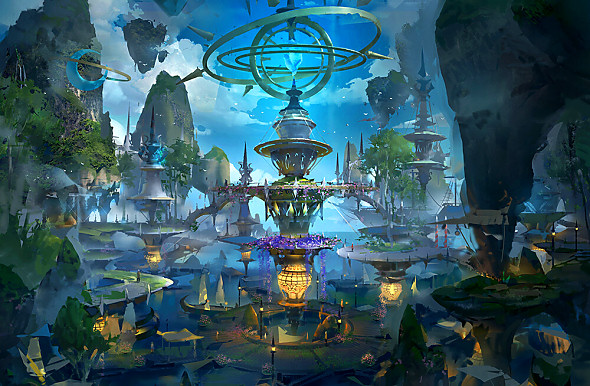
This idea of ‘seven lower planetary systems’ may create the impression in a person’s mind of seven layers of many globe-like planets orbiting in space somewhere below the assumed Earth globe. The term ‘planetary systems’ was Śrīla Prabhupāda’s choice of words, and it is a term that he used consistently, but our modern conception of what might constitute ‘planetary systems’ is wholly different from what is being described by Śukadeva Goswami as seven huge realms within the one vast Earth circle. From the very beginning of Śrīmad Bhāgavatam, Śrīla Prabhupāda was translating verses relating to the Bhū-maṇḍala without even have a map or image of Bhū-maṇḍala to help him conceptualize where each place is situated, and how each place is related to the other.
The Fifth Canto especially presents a detailed description of the universal form that is very difficult to follow without a map, or depiction, or explanation of any kind. Without a map, or image, or explanation, the description of the virāṭ-rūpa (universal form) is very difficult to visualize. Śrīla Prabhupāda invariably used the word ‘planet’ to cover the multitude of places mentioned by Śukadeva Goswami. However, one should be aware that many of the places that Śrīla Prabhupāda refers to as ‘planets,’ are actually references to places upon the Bhū-maṇḍala’s vast landscape, or within the depths of the Bhū-maṇḍala itself (the subterranean realms). They are not ‘other planets’ as we conceive them, but part of the Earth itself. As we shall see presently, the conception of seven layers of globe-like planets floating below the Earth is definitely not what is being described by Śukadeva Goswami.
Another Sanskrit name for the Earth is acala (not moving). The great Earth circle is held in it’s immovable place by Ananta-sesha. The Lord’s pastime of holding the Earth will form the subject of a later paper. Mayesvara Das, What’s Below the Earth?
Description of the Hellish Planets [Naraka-Loka]
Naraka – 28 Hells
The word naraka means “hell.” The Twenty-sixth Chapter of Śrīmad-Bhāgavatam describes how a sinful man goes to different hells, where he is punished in various ways by the assistants of Yamarāja. Śukadeva Gosvāmī affirms the existence of the Naraka planets, which lie between the Garbhodaka Ocean and Pātālaloka. Yamarāja is appointed by the Supreme Personality of Godhead to see that the human beings do not violate His rules and regulations. in the fifth Canto, Śrīmad-Bhāgavatam, Śukadeva Gosvāmī has given a vivid description of the naraka planets, or the hellish planets.
All the hellish planets are situated in the intermediate space between the three worlds and the Garbhodaka Ocean. They lie on the southern side of the universe, beneath Bhū-maṇḍala, and slightly above the water of the Garbhodaka Ocean. Pitṛloka is also located in this region between the Garbhodaka Ocean and the lower planetary systems. All the residents of Pitṛloka, headed by Agniṣvāttā, meditate in great samādhi on the Supreme Personality of Godhead and always wish their families well.
The King of the pitās is Yamarāja, the very powerful son of the sun-god. He resides in Pitṛloka with his personal assistants and, while abiding by the rules and regulations set down by the Supreme Lord, has his agents, the Yamadūtas, bring all the sinful men to him immediately upon their death. After bringing them within his jurisdiction, he properly judges them according to their specific sinful activities and sends them to one of the many hellish planets for suitable punishments. So Yamarāja, his kingdom, his jurisdiction, is within these hellish planets.
Śukadeva Gosvāmī describes the following twenty-eight hells: Tāmisra, Andhatāmisra, Raurava, Mahāraurava, Kumbhīpāka, Kālasūtra, Asi-patravana, Sūkaramukha, Andhakūpa, Kṛmibhojana, Sandaṁśa, Taptasūrmi, Vajrakaṇṭaka-śālmalī, Vaitaraṇī, Pūyoda, Prāṇarodha, Viśasana, Lālābhakṣa, Sārameyādana, Avīci, Ayaḥpāna, Kṣārakardama, Rakṣogaṇa-bhojana, Śūlaprota, Dandaśūka, Avaṭa-nirodhana, Paryāvartana and Sūcīmukha. (Complete description with photos here)
fourteen-worlds.pdf
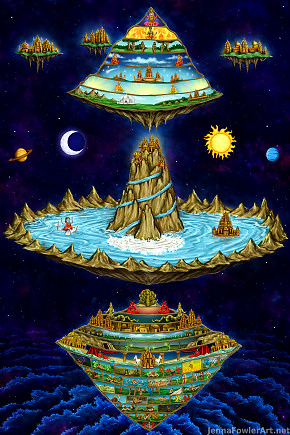
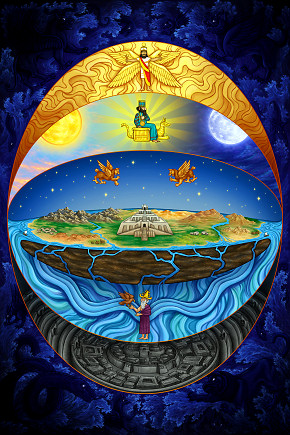
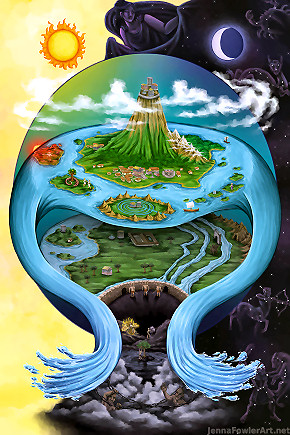
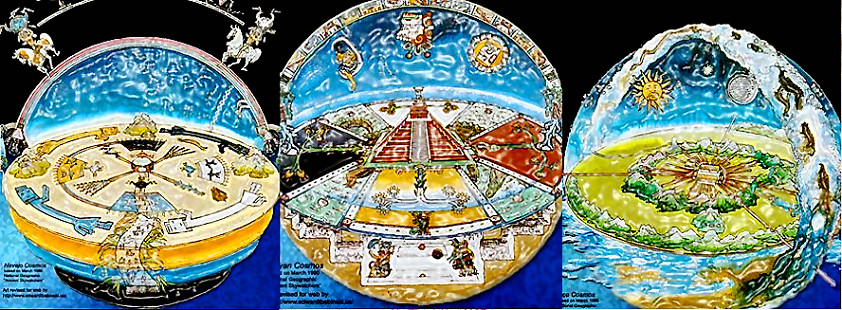
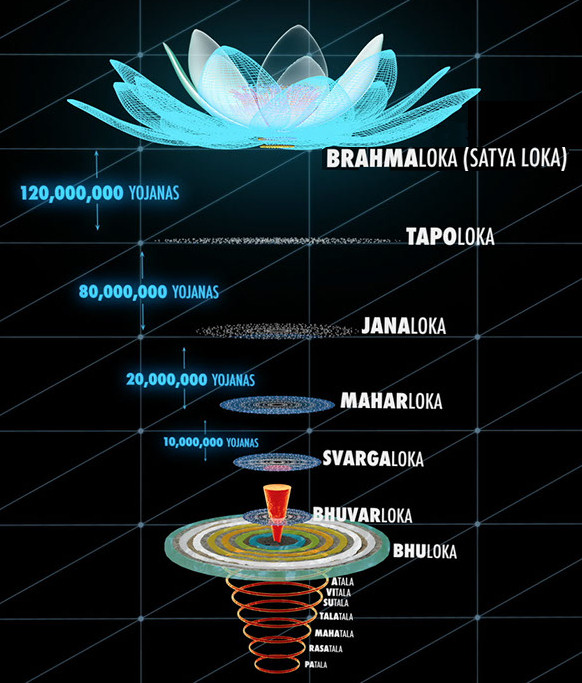

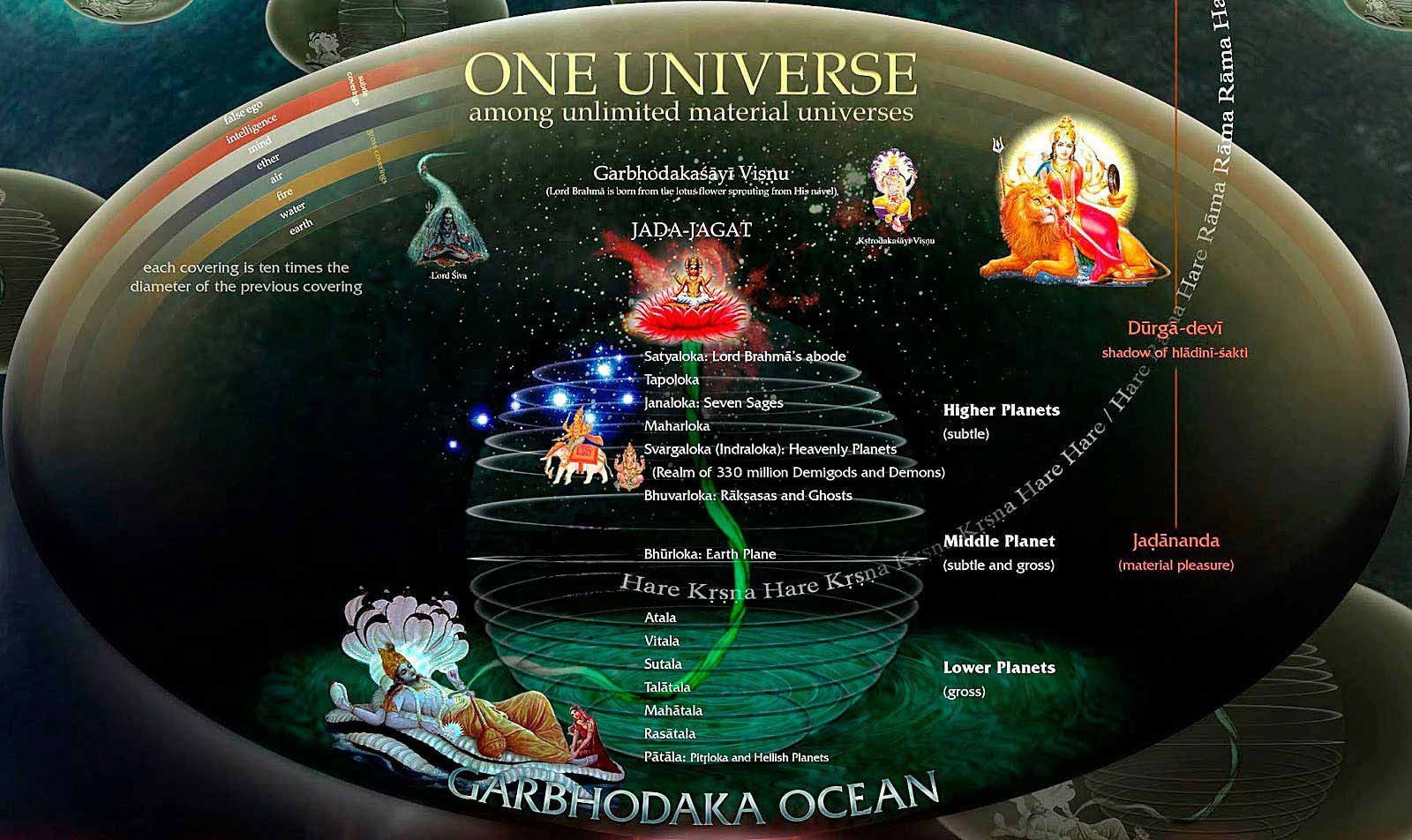
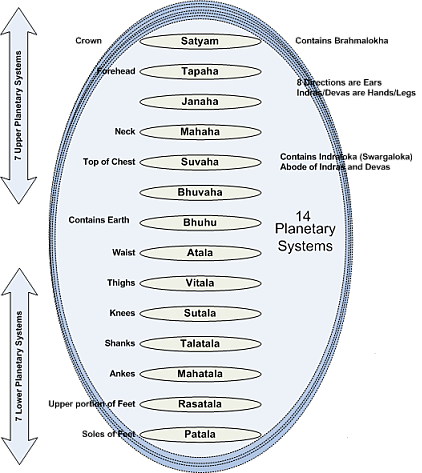
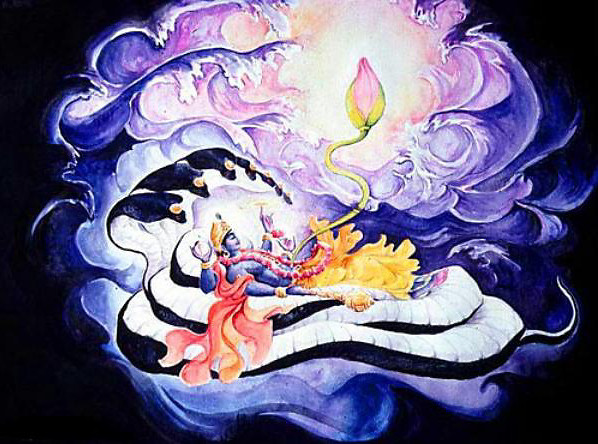
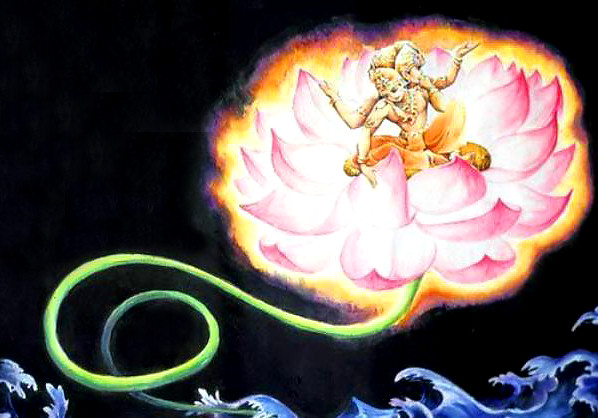
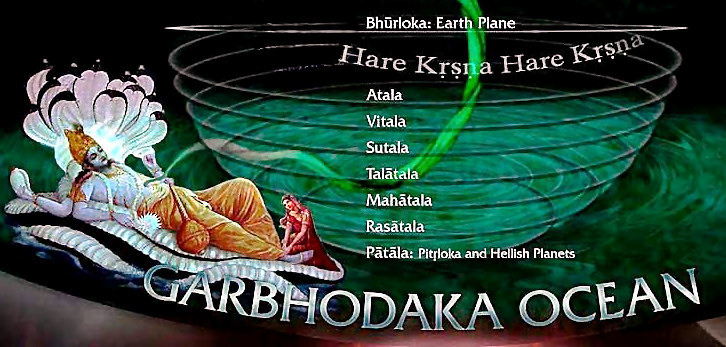

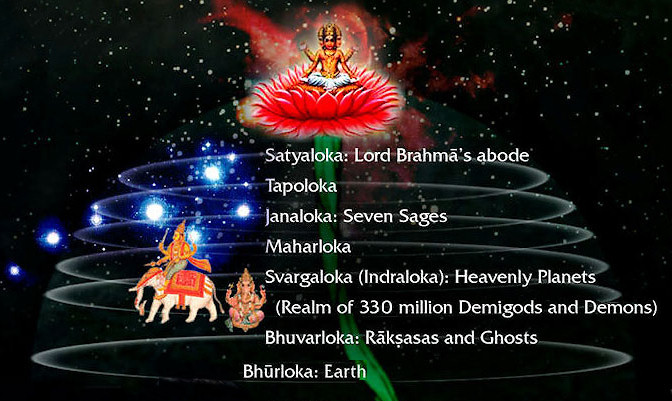
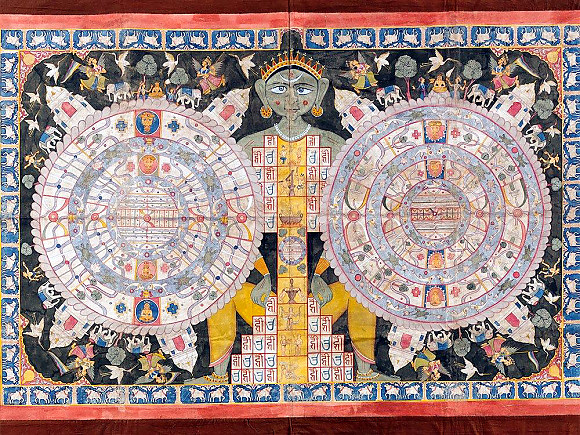
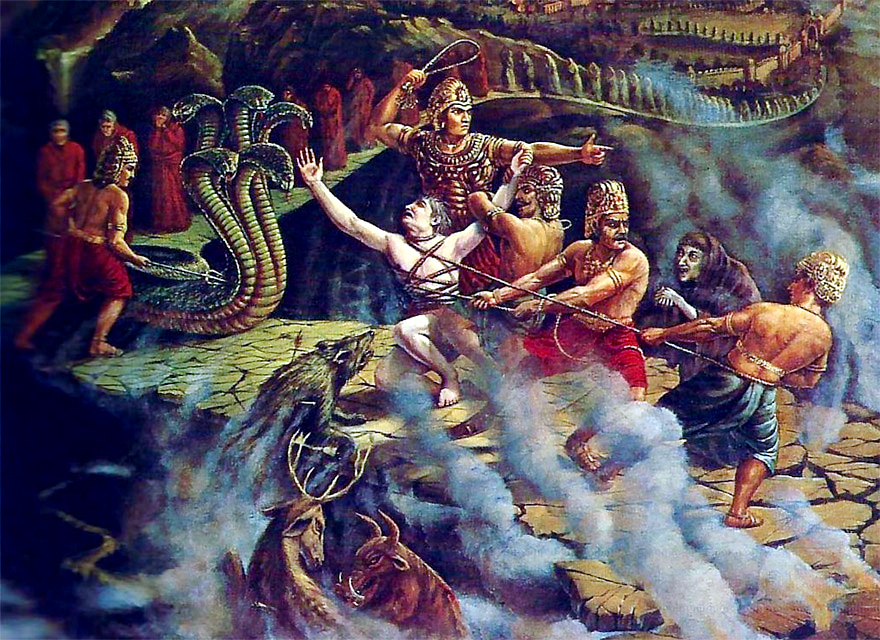
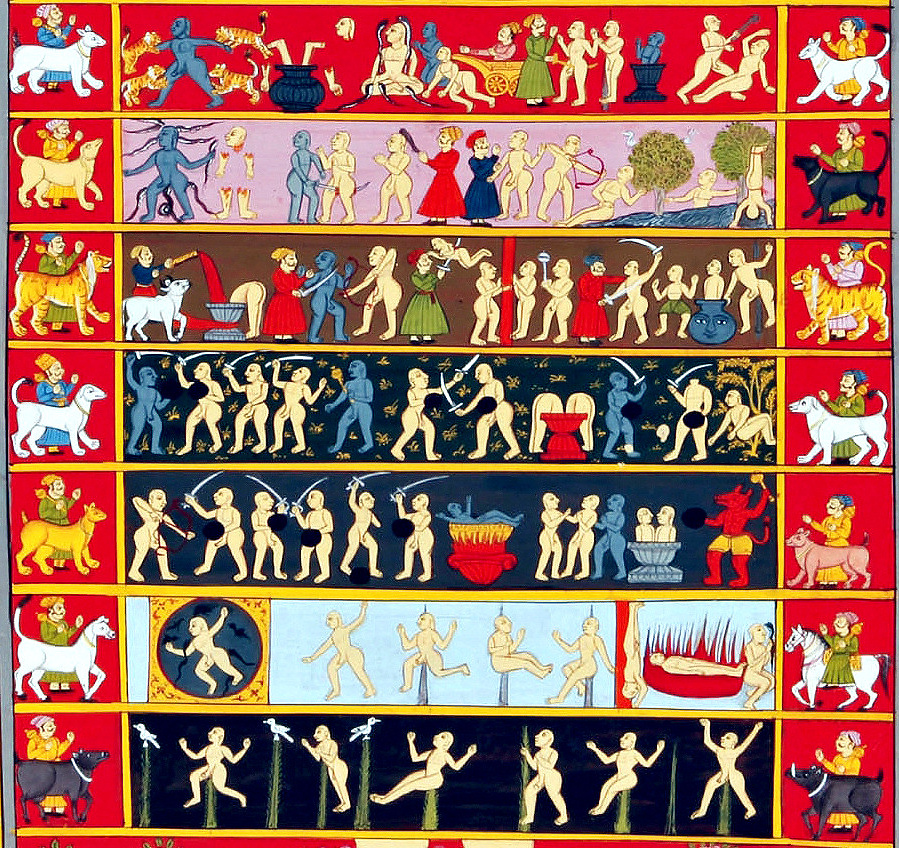







OUTSTANDING!
We are looking forward to going through this whole lengthy piece over the next few weeks while following up on all the references. This presentation is a fine example of real education for people everywhere. Spiritual education is what real education is all about.
Ys Hasti Gopala dasa
Srimad Bhagavatam Chapter 8 Text 19 regarding spiritual education.
The Vedic civilization, however, is based on spiritual education, and spiritual education is the special basis on which Bhagavad-gītā was spoken to Arjuna. In the beginning of Bhagavad-gītā, Kṛṣṇa instructed Arjuna to understand that the spirit soul is different from the body.
dehino ’smin yathā dehe
kaumāraṁ yauvanaṁ jarā
tathā dehāntara-prāptir
dhīras tatra na muhyati
“As the embodied soul continually passes, in this body, from boyhood to youth to old age, the soul similarly passes into another body at death. The self-realized soul is not bewildered by such a change.” (Bg. 2.13) Unfortunately, this spiritual education is completely absent from modern human civilization. No one understands his real self-interest, which lies with the spirit soul, not with the material body. Education means spiritual education. To work hard in the bodily conception of life, without spiritual education, is to live like an animal. Nāyaṁ deho deha-bhājāṁ nṛ-loke kaṣṭān kāmān arhate vid-bhujāṁ ye (Bhāg. 5.5.1). People are working so hard simply for bodily comforts, without education regarding the spirit soul. Thus they are living in a very risky civilization, for it is a fact that the spirit soul has to transmigrate from one body to another (tathā dehāntara-prāptiḥ). Without spiritual education, people are kept in dark ignorance and do not know what will happen to them after the annihilation of the present body. They are working blindly, and blind leaders are directing them.
Pariksit Das: Another Sanskrit name for the Earth is acala (not moving).
Mahesh: No! That is NOT the Sanskrit name of Earth.
Cala and acala are describing the POSITION:
MOVING is called CALA and NOT MOVING is called “a”cala. There is NO SANSKRIT name of Earth as acala.
cala—both of them are MOVING
acala—WITHOUT movement.
TEXT 166
‘brahmānanda’ nāma tumi-gaura-brahma ‘cala’
śyama-varṇa jagannātha vasiyāchena ‘acala’
SYNONYMS
brahmānanda—Brahmānanda; nāma tumi—your name; gaura-brahma—the Brahman of the name Gaura; cala—both of them are moving; śyāma-varṇa—of blackish hue; jagannātha—Lord Jagannātha; vasiyāchena—is sitting; acala—without movement.
TRANSLATION
“Both Brahmānanda and Gaurahari are moving, whereas the blackish Lord Jagannātha is sitting tight and immobile.”
PURPORT
Brahmānanda Bhāratī wanted to prove that there is no difference between the Supreme Lord and the jīva, while Caitanya Mahāprabhu wanted to prove that He and Brahmānanda Bhāratī were jīvas and that although the jīvas are Brahman, they are many, but the Supreme Lord, the Supreme Brahman, is one. On the other hand, Brahmānanda Bhāratī also wanted to prove that Jagannātha and Śrī Caitanya Mahāprabhu are one, the Supreme Personality of Godhead, but that to fulfill His mission Śrī Caitanya Mahāprabhu appeared to be moving whereas Lord Jagannātha appeared to be inert. Thus this jolly argument was going on. Finally, Brahmānanda Bhāratī referred the whole matter to Sārvabhauma Bhaṭṭācārya for a final decision.
Link to this page: https://prabhupadabooks.com/cc/madhya/10/166
Note: Further reference:
JUST LIKE THE EARTH HAS ITS ORBIT—IT IS ROTATING—SIMILARLY, EVERY PLANET IS ROTATING
http://www.prabhupadanugas.eu/news/?p=48862#comment-52095
Stationary Earth?
The difference between SPIN and ROTATE
http://www.prabhupadanugas.eu/news/?p=49124#comment-52172
Pariksit Das: Another Sanskrit name for the Earth is acala (not moving).
Mahesh: it is NOT good to BLUFF devotees by MANIPULATING to make beLIEve(in other words LIE) that the Earth is stationary to fit in with your personal agenda: “The great Earth circle is held in it’s immovable place by Ananta-sesha”. IMMOVABLE?????
This business about “Sanskrit name for Earth is acala (not moving)” is a self-serving agenda.
Sanskrit NAME of EARTH is NOT MOVING???? Does it even make SENSE–at all ????? Just see!
Come on Pariksit Prabhu, let us not pretend. What Mayesvara Das and your intention is to SOMEHOW fit in the earth as NOT MOVING on Ananta-sesha’s head. THAT is YOUR ploy. It is MENTAL SPECULATION.
Best to take Srila Prabhupada’s words instead:
JUST LIKE THE EARTH HAS ITS ORBIT—IT IS ROTATING—SIMILARLY, EVERY PLANET IS ROTATING
http://www.prabhupadanugas.eu/news/?p=48862#comment-52095
Stationary Earth?
The difference between SPIN and ROTATE
http://www.prabhupadanugas.eu/news/?p=49124#comment-52172
Pariksit das: Śrīla Prabhupāda invariably used the word ‘planet’ to cover the multitude of places mentioned by Śukadeva Goswami. However, one should be aware that many of the places that Śrīla Prabhupāda refers to as ‘planets,’ are actually references to places upon the Bhū-maṇḍala’s vast landscape, or within the depths of the Bhū-maṇḍala itself (the subterranean realms). They are not ‘other planets’ as we conceive them, but part of the Earth itself. As we shall see presently, the conception of seven layers of globe-like planets floating below the Earth is definitely not what is being described by Śukadeva Goswami. (Please refer to: Mayesvara Das, What’s Below the Earth? , Oct 2017)
Mahesh: Just look at this MENTAL SPECULATION: Where is this Bhū-maṇḍala’s VAST LANDSCAPE in Srimad Bhagavatam????????? WHERE does Srila Prabhupada say it is VAST LANDSCAPE?????
“However, one should be aware that MANY of the places that Śrīla Prabhupāda refers to as ‘PLANETS,’ are actually references to places upon the Bhū-maṇḍala’s VAST LANDSCAPE, or within the depths of the Bhū-maṇḍala itself (the subterranean realms). They are not ‘other planets’ as we conceive them,”
Note: Srila Prabhupada did NOT say he wanted what he spoke INTERPRETED to suit what YOU and Mayesvara das think HOW IT SHOULD BE. When Srila Prabhupada says PLANETS he MEANS PLANETS. There are no “if” and no “buts”. NO MENTAL SPECULATIONS.
TEXT 31
ye vā u ha tad-ratha-caraṇa-nemi-kṛta-parikhātās te sapta sindhava āsan yata eva kṛtāḥ sapta bhuvo dvīpāḥ.
SYNONYMS
ye—that; vā u ha—certainly; tat-ratha—of his chariot; caraṇa—of the wheels; nemi—by the rims; kṛta—made; parikhātāḥ—trenches; te—those; sapta—seven; sindhavaḥ—oceans; āsan—became; yataḥ—because of which; eva—certainly; kṛtāḥ—were made; sapta—seven; bhuvaḥ—of the Bhū-maṇḍala; dvīpāḥ—islands.
TRANSLATION
When Priyavrata drove his chariot behind the sun, the rims of his chariot wheels created impressions that later became seven oceans, dividing the planetary system known as Bhū-maṇḍala into seven islands.
PURPORT
Sometimes the PLANETS in outer space are called islands. We have experience of various types of islands in the ocean, and similarly the various planets, divided into fourteen lokas, are islands in the ocean of space. As Priyavrata drove his chariot behind the sun, he created seven different types of oceans and planetary systems, which altogether are known as Bhū-maṇḍala, or Bhūloka. In the Gāyatrī mantra, we chant, oṁ bhūr bhuvaḥ svaḥ tat savitur vareṇyam. Above the Bhūloka planetary system is Bhuvarloka, and above that is Svargaloka, the heavenly planetary system. All these planetary systems are controlled by Savitā, the sun-god. By chanting the Gāyatrī mantra just after rising early in the morning, one worships the sun-god.
Link to this page: https://prabhupadabooks.com/sb/5/1/31
++++++++++++++++++++++++++++++++++++++++++++++++
TEXT 43
prekṣayitvā bhuvo golaṁ
patnyai yāvān sva-saṁsthayā
bahv-āścaryaṁ mahā-yogī
svāśramāya nyavartata
SYNONYMS
prekṣayitvā—after showing; bhuvaḥ—of the universe; golam—the globe; patnyai—to his wife; yāvān—as much; sva-saṁsthayā—with its arrangements; bahu-āścaryam—full of many wonders; mahā-yogī—the great yogī (Kardama); sva-āśramāya—to his own hermitage; nyavartata—returned.
TRANSLATION
After showing his wife the globe of the universe and its different arrangements, full of many wonders, the great yogī Kardama Muni returned to his own hermitage.
PURPORT
ALL the PLANETS are here described as gola, round. Every PLANET is round, and each PLANET is a different shelter, just like islands in the great ocean. PLANETS are sometimes called dvīpa or varṣa. This EARTH PLANET is called Bhārata-varṣa because it was ruled by King Bharata. Another significant word used in this verse is bahv-āścaryam, “many wonderful things.” This indicates that the different planets are distributed all over the universe in the eight directions, and each and every one of them is wonderful in itself. Each planet has its particular climatic influences and particular types of inhabitants and is completely equipped with everything, including the beauty of the seasons. In the Brahma-saṁhitā (5.40) it is similarly stated, vibhūti-bhinnam: on each and every planet there are different opulences. It cannot be expected that one planet is exactly like another. By God’s grace, by nature’s law, each and every planet is made differently and has different wonderful features. All such wonders were personally experienced by Kardama Muni while he traveled with his wife, yet he could return again to his humble hermitage. He showed his princess-wife that although he was living in the hermitage, he had the power to go everywhere and do anything by mystic yoga. That is the perfection of yoga. One cannot become a perfect yogī simply by showing some sitting postures, nor by such sitting postures or so-called meditation can one become God, as is being advertised. Foolish persons are misled into believing that simply by some caricature of meditation and sitting postures one can become God within six months.
Here is the example of a perfect yogī; he could travel all over the universe. Similarly, there is a description of Durvāsā Muni, who also traveled in space. Actually, the perfect yogī can do that. But even if one can travel all over the universe and show wonderful feats like Kardama Muni, he cannot be compared to the Supreme Personality of Godhead, whose power and inconceivable energy can never be attained by any conditioned or liberated soul. By the actions of Kardama Muni we can understand that in spite of his immense mystic power, he remained a devotee of the Lord. That is the real position of every living entity.
Link to this page: https://prabhupadabooks.com/sb/3/23/43
+++++++++++++++++++++++++++++++++++++++++++++++
Here is Srila Prabhupada’s version:
ALL THE PLANETS AND THE UNIVERSES, THEY ARE EGG SHAPED
http://www.prabhupadanugas.eu/news/?p=48520
Dear Learned Prabhus,
I am really and truly shocked to read the writing of compilation by Pariksit Das Prabhu with POLLUTED consciousness as brought out by Shriman Mahesh Prabhu’s comments.
What I mean by polluted consciousness is that Self Interested interpreter interprets using the same textual elements of the revealed Scripture i.e. Srimad Bhagavatam etc. to expound different ideas of their own to fulfill their Agenda which unnecessarily creates contradictions and destroys the total essence of their writings misleading massive innocent true seekers far far away from the truth of the subject matter presented asitis by the bonafide Acaraya HDG. Srila Prabhupada’s VANI.
My humble suggestion to Pariksit Das is that he must remove from his compilations all the misrepresentation in the article in order to create the real authenticated presentation as per Srila Prabhupada’s instruction.
No doubt, there are some very good explanation but due to the presence of the tainted writings taken from Mayesvara dasa and so on, the true value of the essence in the article has been lost. That is why it becomes imperative that the polluted writings must be removed which contradict Srila Prabhupadas instructions as per Scripture.
For example, we must incorporate in the article the instructions from the various letters of Srila Prabhupada such as ;
a. July 05, 1977 Vrindavana discussion about Bhu-Mandala.
b. April 27, 1976 letter to Svarupa Damodara
c. Dec. 20, 1968 letter to Rupanuga in which Srila Prabhupada clearly states that the Planets are arranged in each Universe in LAYERS like the Petals of a Lotus. But in each Layer there is mixed both Heavenly, Hellish and Middle planets on the outside Layer there are these three kinds of planets …….
These are very important point of discussions which I bring out and need to be incorporated in the Article to level up to the instructions of HDG. Srila Prabhupada’s Instructions.
I do sincerely hope that a good council from the Learned Readers may bring improvement in the present discussion about the article in order to reach some desirable, attainable and meaningful achievement so that it can benefit ALL OF US in further learning
OM TAT SAT.
All Glories to Srila Prabhupada.
Amar Puri:That is why it becomes imperative that the polluted writings must be removed which contradict Srila Prabhupadas instructions as per Scripture.
For example, we must incorporate in the article the instructions from the various letters of Srila Prabhupada such as ;
a. July 05, 1977 Vrindavana discussion about Bhu-Mandala.
b. April 27, 1976 letter to Svarupa Damodara
c. Dec. 20, 1968 letter to Rupanuga in which Srila Prabhupada clearly states that the Planets are arranged in each Universe in LAYERS like the Petals of a Lotus. But in each Layer there is mixed both Heavenly, Hellish and Middle planets on the outside Layer there are these three kinds of planets …….
These are very important point of discussions which I bring out and need to be incorporated in the Article to level up to the instructions of HDG. Srila Prabhupada’s Instructions.
Mahesh: here are the letters that MUST BE INCLUDED UNDER Srila Prabhupada’s direction:
Letter to: Svarupa Damodara
—
Auckland
27 April, 1976
76-04-27
Atlanta
My dear Svarupa Damodara Das,
Please accept my blessings. Now our Ph.D’s must collaborate and study the 5th Canto to make a model for building the Vedic Planetarium. My final decision is that the universe is just like a tree, with root upwards. Just as a tree has branches and leaves so the universe is also composed of planets which are fixed up in the tree like the leaves, flowers, fruits, etc. of the tree. The pivot is the pole star, and the whole tree is rotating on this pivot. Mount Sumeru is the center, trunk, and is like a steep hill, like the alps mountains which also have very high peaks. I have seen in Switzerland one mountain peak which was so high that is penetrated through the clouds. The tree is turning and therefore, all the branches and leaves turn with the tree. The PLANETS have their FIXED ORBITS, but still they are turning with the turning of the great tree. There are pathways leading from one planet to another made of gold, copper, etc., and these are like the branches. Distances are also described in the 5th Canto just how far one planet is from another.
We can see that at night, how the whole planetary system is turning around, the pole star being the pivot. EACH PLANET has its ORBIT FIXED but the sun is moving up and down, north and south. It is not that we shall accept the theory that the sun is fixed up and the others are all going around the sun. That is not correct. Even the 7th star is rotating once around the pole star in each 24 hours. The whole universe is just like a big tree, that is a fact. I do not think that the modern astronomers have any such idea that the whole universe is like a big tree. The planets which are full of living entities are one after another, one above the other. The relative positions of the planets is fixed up but the whole thing is turning. The sun is going north and south, it has its own orbit below the moon. So now you all Ph.D.’s must carefully study the details of the 5th Canto and make a working model of the universe. If we can explain the passing seasons, eclipses, phases of the moon, passing of day and night, etc. then it will be very powerful propaganda.
I am sending this letter to you, and you can make photocopies of it and send to our other Ph.D.’s and begin serious research into the matter in detail. But one thing, I am convinced that the universe is just like a great tree as described therein.
I hope that this meets you in good health.
Your ever well-wisher,
A.C. Bhaktivedanta Swami
ACBS/pks
Link to this page: https://prabhupadabooks.com/letters/auckland/april/27/1976/svarupa_damodara
++++++++++++++++++++++++++++++++++++++++++++++++++++++++
Letter to: Rupanuga
—
Los Angeles
20 December, 1968
68-12-20
Regarding your question of the planetary systems, the planets are arranged in each universe in layers like the petals of a lotus. But in each layer there is mixed both heavenly, hellish and middle planets. On the outside layer there are these three kinds of planets, on the middle layers there are the three kinds of planets and on the inner-most layer there are found these three kinds of planets. Above these layers, in the center, is the Brahmaloka where Lord Brahma, the creator is residing. So the earth planet and the moon planet are both on the same layer but the earth is middle planet and the moon is heavenly planet.
Link to this page: https://prabhupadabooks.com/letters/los_angeles/december/20/1968/rupanuga
Dear Learned Readers,
Important letters of Srila Prabhupada instructions as brought out in my comments, and later reproduced in its entirety by Mahesh Prabhu indicate strongly that these Instructions of Srila Prabhupada becomes a Part and Parcel of the presentation of the Cosmology as per the Fifth Canto of the Srimad Bhagavatam Srila Prabhupada desires and instructs to His disciples to follow through in order to educate people about the Universal affairs how it operate.
But unfortunately, these people Pariksit das team headed by Mayesvara das do present in their writings against Srila Prabhupada’s Instructions duly twisted and turned to best suit their personal agenda.
I wonder WHY ?
These people are in a position to incorporate exactly as per Srila Prabhupada instructions as He desires but because of their own motivated agenda they mislead in their presentation using only Srila Prabhupada instructions where ever and when ever it suits their motive in their presentation. That is the dilemma.
These people are equipped with the necessary technology ( CGI ) to produce such model of the Universe as per Srila Prabhupada’s Instructions but they will not use the facility they have and , therefore, they will not create SUCH model of the Universe as per Srila Prabhupada’s instruction because their personal motivated agenda make them blind. That is very very unfortunate.
I hope there are some learned Readers out there who are interested to help us in this regard for further advancement in the presentation of the Universe model because I am very much ignorant to the technology myself. That is what makes me some what handicapped in this area.
OM TAT SAT.
Hare Krishna. All Glories to Srila Prabhupada.
Flat Earth is a Psyop created with the help of CIA, Tavistock and other agencies to attempt to discredit truth sites, whistleblowers and those who ‘challenge’ false information (which pours out constantly from TV screens, newspapers, “educational” institutions). Obama used this ”flat earth” psyop extensively to discredit those persons who challenged ‘The CO2 Global Warming” propaganda by saying that they were a throwback to the medieval age etc etc. CO2 Global Warming Hoax is the Trogan Horse to usher in Agenda 21 (which most people are ignorant of) which was “ratified” AT THE SAME TIME at the RIO Earth Summit (1992).
Flat Earth Psy Op is the Real Conspiracy – The Millennium Report
[Search domain themillenniumreport.com/2016/08/flat-earth-psy-op-is-the-real-conspiracy/] themillenniumreport.com/2016/08/flat-earth-psy-op-is-the-real-conspiracy/
While describing the character of Mahārāja Priyavrata and his descendants, Śukadeva Gosvāmī also described Meru Mountain and the planetary system known as Bhū-maṇḍala. Bhū-maṇḍala is like a lotus flower, and its seven islands are compared to the whorl of the lotus. The place known as Jambūdvīpa is in the middle of that whorl.
S.B. 5.16.2 states ; “My dear Lord, the rolling wheels of Mahārāja Priyavrata’s chariot created seven ditches, in which the seven oceans came into existence. Because of these seven oceans, Bhū-maṇḍala is divided into seven islands. …..”
S.B.5.16.4 states ; “….. O King, I shall nevertheless try to explain to you the principal regions, such as Bhū-goloka [Bhūloka], with their names, forms, measurements and various symptoms. ”
The word jugglery of Mayesvara dasa misleading description of the greater Earth-circle (Bhu-mandala) bhū-golaka-viśeṣam—the particular description of Bhūloka tactfully creates smoke screen when he says ;
” By flat we mean a landscape that continues along a horizontal plane, as opposed to a landscape that curves around the surface of a globe. ”
Mayesvara dasa continues in his writing on Sampradaya Sun ; A Reply to Danavir Goswami’s “Flat-Earth or
Globular Earth?” BY: MAYESVARA DASA Jun 08, 2019 (SUN) — In the above article, Danavir Goswami presents a footnote from Srila Bhaktisiddanta Sarasvati Thakura regarding four different measurements for the size of a small area of Earth. Danavir Goswami presents this as his first piece of evidence for a globular-shaped Earth. In this paper we shall demonstrate that there is only one Earth in the Vedic cosmos, and it is not a globe…………..
S.B. 3.13.40 says ; ” O lifter of the earth, the earth with its mountains, which You have lifted with Your tusks, is situated as beautifully as a lotus flower with leaves sustained by an infuriated elephant just coming out of the water. ”
” ………. Some portion of the earth is flat. When you stand in any place you see flat, so for us to some extent it appears flat, but it is round …… ” as described in the .Letter dated 76-10-03 from Srila Prabhupada to Madhava.
Dear Learned Readers, it is interesting to read and note that how these two notoriously known so called authority on the Cosmology namely Dhanvir Swami and Mayesvara dasa are exposing each other against Srila Prabhupada’s Instructions on the subject matter.
How both of them do not follow through Srila Prabhupada’s Instructions as He desires , and yet they stick to their own respective agendas in order to cheat and mislead people.
OM TAT SAT.
Hare Krishna. All Glories to Srila Prabhupada.